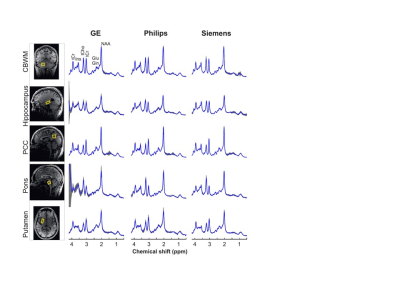Weekend Educational Session
Advanced Spectroscopy
Session Topic: Advanced Spectroscopy
Session Sub-Topic: Advanced Spectroscopy
Weekend Course
ORGANIZERS: Malgorzata Marjanska, Wolfgang Bogner
| Saturday Parallel 2 Live Q&A | Saturday, 8 August 2020, 15:00 - 15:30 UTC | Moderators: Graham Galloway & Esin Ozturk-Isik |
Skill Level: Advanced
Session Number: WE-21
Overview
This course will focus on advanced topics in MR spectroscopy, such as radio frequency pulse design, MRSI encoding techniques, motion and instability correction, ultra-high field, and macromolecules. It will also cover how to transition from single-site studies to multi-center MRS/MRSI studies.
Target Audience
Researchers and clinical users of spectroscopy trying to go beyond standard clinical MRS.
Educational Objectives
As a result of attending this course, participants should be able to:
- Summarize different advanced MRS methods;
- Describe critical issues in MRS methods; and
- List current clinical and research applications of MRS.
| Single-Voxel Spectroscopy at 7T & Beyond: From Animal to Human
Dinesh Deelchand
This lecture focuses on the pros and cons of utilizing single-voxel proton MR spectroscopy at ultra-high fields (UHF) of 7T and beyond in both human and animal brains. Advantages include higher signal-to-noise ratio, higher spectral dispersion i.e. less overlap between metabolites and these benefits lead to improved quantification of metabolites. However in human brain, going to UHF is associated with B1 inhomogeneity and increased RF power requirements and these can be mitigated by using dielectric pads or B1 shimming techniques. In addition, relaxation times of metabolites and water tissue signals change as B0 field increases.
|
||
| MRSI Encoding Techniques: Comparison, Advantages & Disadvantages
Anke Henning
|
||
 |
Multicenter MRS/MRSI Studies: What to Do & How
Eva-Maria Ratai
Imaging biomarkers may be used to help identify the natural history of disease progression, monitor therapeutic response, and identify side effects. 1H MRS offers the unique ability to measure metabolite levels in a non-invasive manner and has been widely used to access metabolisms in the brain, muscle, liver, prostate, breast, kidney, etc. However, MRS has only infrequently used in multi-center clinical trials. Here we discuss the potential and limitations of the techniques and suggest recommendations for the application of MRS to multi-center clinical trials.
|
|
| Importance of Macromolecules for Quantification of Full Neurochemical Profile & GABA Editing
Lijing Xin
Mobile macromolecules (MM) present as broad resonances underlying sharp metabolite resonances in 1H MR spectra at short to moderate TEs. The accurate estimation of MM is an important prerequisite for reliable quantification of metabolites. This lecture covers up-to-date knowledge about MM, how to handle MM for MRS quantification, and also some open questions.
|
||
| RF Pulse Design: From Adiabatic RF Pulses to Tailored MRS Volumes
Jürgen Finsterbusch
RF pulses are essential for every MR experiment and an important tool to manipulate the magnetization during the experiment. Important parameters of an RF pulse are the complex envelope, the duration, and the peak transmitter voltage that define the pulse’s energy, the frequency spectrum, and flip angle. Depending on the purpose of the RF, the desired properties, and the boundary conditions, different RF pulse envelopes may be advantageous. In this presentation, the principles and basic properties of adiabatic, spatial-spectral, and multi-dimensional RF pulses will be covered with the latter being feasible to realize tailored measurement volumes in MRS.
|
||
| Motion & Instability Correction in MRS/MRSI (Prospective [Acquisition] & Retrospective [Post-Processing])
Ernesta Meintjes
|

 Back to Program-at-a-Glance
Back to Program-at-a-Glance Watch the Video
Watch the Video Back to Top
Back to Top